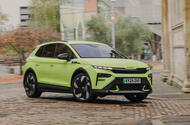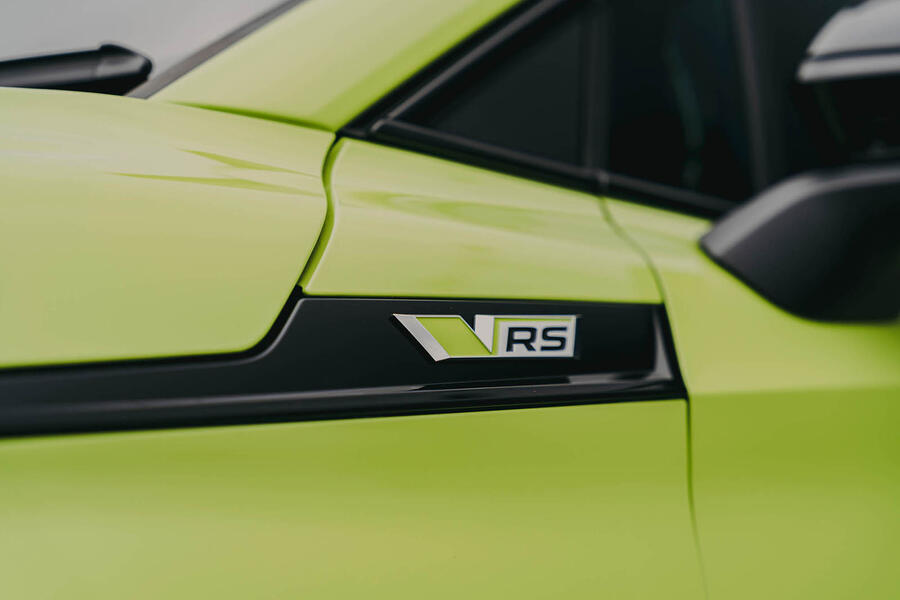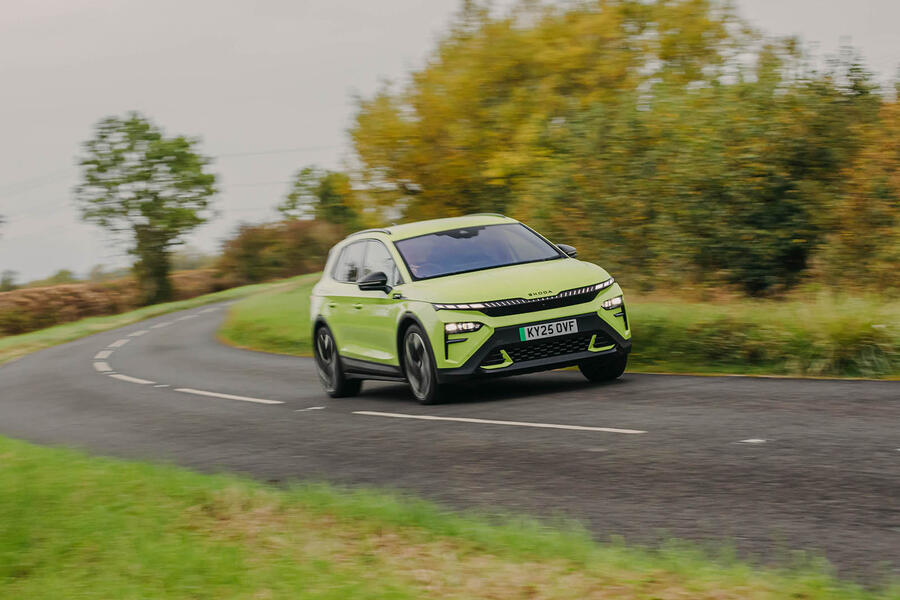Recent Updates
11/12/2025 12:00 PM
From punchline to performer: 130 years of Skoda
11/12/2025 12:00 PM
My Week in Cars: Cropley buys another car
11/12/2025 12:00 PM
I put new wheels on my £500 Audi - now it does 72mpg
11/12/2025 12:00 PM
Citroen e-C3
11/12/2025 12:00 PM
Reborn Ford Escort RS to rev to 10,000rpm
11/12/2025 12:00 PM
Omoda 7 ICE SUV to land in January, priced from £29,915
11/12/2025 12:00 PM
The biggest loser of the pay-per-mile EV tax? The government
11/12/2025 12:00 AM
Nissan promises electric Juke will be 'Marmite' as road tests begin
11/12/2025 12:00 AM
Zeekr 7X
11/12/2025 12:00 AM
Ford to show new road-going sports car at F1 launch in January
EV, Hybrid, Hydrogen, Solar & more 21st century mobility!
 We take you on a remarkable journey all the way back to the beginning
We take you on a remarkable journey all the way back to the beginning
One hundred and thirty years: by any measure it’s a fair stretch. Beyond any single human’s existence, it’s a passage of time that’s hard to get your head around.Â
It’s almost ancient history. So any company, organisation or institution that makes it this far deserves a pat on the back. For two to get to the same milestone at more or less the same time demands nothing less than a celebration, which is why we’re here today.Â
You see, back in 1895, in a small town called Mladá Boleslav, located in what is now the Czech Republic, an enterprising bookshop owner called Václav Klement teamed up with meticulous engineer Václav Laurin to set up a factory making bicycles.Â
If their surnames seem familiar, it’s because they’re now used to identify the flagship models of the car company that quickly grew out of this fledgling pushbike arm: Skoda.Â
At the same time as the Václavs were bolting together their first bikes, over here in the UK the very first issue of The Autocar appeared hot off the presses. Like Laurin & Klement’s formative years, this magazine owes its existence to the bicycle, as its founding owners, Illife, Sons and Sturmey, made their name as publishers of The Cyclist.Â
Spotting the potential of the new-fangled four-wheeled horseless carriage, they joined forces with automotive entrepreneur Harry Lawson to launch a periodical dedicated to the new transportation technology.Â
Fast forward 130 years and both concerns are still going strong and are bigger and better than their early owners could ever have imagined. So what better way to celebrate than with a road trip? But where shall we go? A trip from Skoda’s home in Mladá Boleslav to Autocar Towers in Twickenham would be the obvious choice, but instead we’re heading from central London to Coventry. Why?Â
Well, as we will see, both of these locations played a significant role in our birthday pair’s history. While Laurin & Klement started out making bicycles, by 1898 it had turned its attention to the internal combustion engine and motorcycles.Â
Seven years later, it launched its first car, a small two-seater called the Voiturette A. Powered by a 7bhp 1.0-litre twin-cylinder engine, it set the company on a path to becoming the biggest car manufacturer in the Austro-Hungarian Empire.
In fact, by 1908 Laurin & Klement had become successful enough that it started to establish overseas sales offices, including one in the UK (there were also outlets in New Zealand, Russia and Japan), which is why we have started our journey on a busy Monday morning on bustling Tottenham Court Road in the centre of the capital.Â

It was here in 1909 that The Autocar’s testers visited the Bohemian brand’s depot and sampled three of its new models, concluding that “the Laurin & Klement car will soon increase rapidly in popularityâ€. Of course, when we arrive today, there’s no trace of the company’s pioneering showroom (255 Tottenham Court Road is now a branch of health food retailer Holland & Barrett).Â
More to the point, we can’t even get near the old site in a car, because camera-controlled traffic restrictions mean only buses, cabs and bicycles are welcome on this stretch of road after 8am.Â
With commuter traffic building, we satisfy ourselves with some pictures outside the tube station before turning our noses north. The traffic is now moving with all the speed of treacle through a straw, as cars, buses and black cabs jostle with pushbikes and pedestrians for increasingly limited space.Â
It’s the sort of situation that should spike blood pressure and fray tempers, but the cabin of our electric Elroq vRS is actually an oasis of calm. With 335bhp, the vividly coloured crossover is Skoda’s most potent offering ever, yet with its smooth and silent power delivery, supple adaptive dampers and subtly elevated driving position, it’s making our stuttering progress far more bearable.Â

As we make slow progress out of London and towards the M1, it gives us more time to ponder the car maker’s remarkable story. For the next decade or so, Laurin & Klement continued evolving its cars, sticking to the same principle of producing high-quality but fairly traditional saloons.Â
The onset of the First World War meant it diversified into military vehicles and agricultural equipment. Then in 1925 the founding partners struck a deal with the Skoda Works, and at the following year’s Prague motor show the new ‘Skoda’ brand was unveiled, with the Type 150 roadster being the first bespoke model to proudly wear the winged-arrow logo.Â
Just under a decade later, some familiar names started to appear in the form of the Rapid and Superb, part of a family of cars alongside the aptly monikered Popular that featured a relatively light and strong tube-frame chassis and OHV engines.Â
Yet just as Skoda was getting into its stride, the outbreak of the Second World War meant Mladá Boleslav was once again commandeered for military work.Â
When hostilities ended in 1945, Czechoslovakia became part of the post-war communist bloc and Skoda was effectively taken under state control. Largely cut out from the rest of Europe, the company continued to make cars and, despite being isolated in engineering terms, models such as the Octavia and Felicia carried on Skoda’s tradition for quality and style.Â

We have managed to fight our way to Staples Corner and the bottom of the M1, and as we get to the head of the queue at the traffic lights, the motorway’s entry slip road stretches temptingly before us. Finally, we get the green signal and the Elroq vRS is unleashed, the dual-motor four-wheel drive system catapulting us away from rest with real neck-straining energy. With a 5.4sec 0-62mph time, this is the fastest-accelerating machine Mladá Boleslav has ever bolted together.Â
Once up to speed, it’s the refinement that strikes you, and the loping ride. The large, 21in alloys can cause a little crashiness over sharper imperfections, but with the dampers set to their plushest and the figure-hugging seat supporting you in all the right places, the Elroq vRS does a remarkably fine impression of an executive express.Â
Construction of this southern stretch of the M1 started in the mid-1960s, by which time this magazine had lost its definite article to become simply Autocar. Our industry-leading road tests had also been a weekly staple for more than three decades, with quite a few Skodas being subjected to the testers’ timing gear and tape measures. Even so, Mladá Boleslav’s motors remained a niche choice for buyers, who preferred their wheels to come from established brands this side of the Iron Curtain.Â
Then, in 1964, Skoda launched the 1000MB, a quirky, rear-engined family saloon that caught the imagination of budget-conscious overseas buyers. When we ran the rule over the car in June 1965, we declared it comfortable, “unusually well equipped†and offering “good economyâ€.Â
However, that rear-engined layout and swing-axle rear suspension meant that on-limit oversteer was also the order of the day. Still, the most important thing was that the 1000MB became Skoda’s first car to hit a million sales, encouraging the firm to follow this template for future models over the next two decades.Â
Moreover, it marked Skoda out as an eastern European brand that did things differently. While fellow state-run manufacturers such as Lada (of the USSR) FSO (Poland) and Yugo (Yugoslavia) raided the Fiat back catalogue, the men and women of Mladá Boleslav followed their own path.Â
By the 1970s, Skoda had almost entirely gone the rear-engined route, refining the concept into the stylish 110R coupé and then the all-new Type 742. On the showroom floor, these were known as the 105 (1.0-litre) and 120 (1.2-litre). Here in the UK, they were christened the Estelle.Â
Much more modern in looks and with the handling tamed, they offered the reliability, quality and warranty of a new car but at the price of a smaller second-hand machine.
Of course, for many this era of Skoda is defined by the jokes. As the excess-all-areas, aspirational 1980s took hold, these cheerful Czechoslovakian offerings became the punchline for comedians looking for a cheap laugh.Â
Yet for those who actually drove the cars, the reality was rather different. Sure, they couldn’t match the best in the West for ultimate sophistication and comfort, but they were solidly built, packed a decent haul of kit and had genuine space for the family.Â
Towards the end of their life, they were even entertaining to drive. Really. In 1988, we went as far as placing a 136 Rapid Coupé on the cover under the bold headline: “What handles like a Porsche, costs only £4200 and is more fun than a GTI?†Words very much unminced. That year was significant for other reasons too. For starters, Haymarket, Autocar’s publisher since 1984, made a winning bid for weekly archrival Motor, creating the slightly clunkily titled Autocar & Motor (surprisingly, the name stuck until September 1994).Â
Over in Mladá Boleslav, there was also a radical change in direction. After decades of slavishly sticking to its outrigger engine philosophy, Skoda joined the rest of the world in launching a bang-up-to-date, front-wheel-drive, five-door family hatchback. More to the point, it called on a few influential Western names to give its new creation a fighting chance in its determined effort to join the mainstream. Called the Favorit, it featured crisp Bertone lines, an all-new, all-alloy 1.3-litre engine and, incredibly, suspension honed by Porsche.Â

The result was a remarkably capable machine that offered family car space and versatility at a supermini price.Â
When we put the Favorit through its road testing paces in 1989, we concluded that the new Skoda was “a well-balanced car with a thoroughly competent chassis and a willing engine. The Favorit represents a big step forward.â€Â
We have peeled off the M1 and hooked up with the A5 as we set a course for Milton Keynes, Skoda’s UK home. There’s symbolic value in this destination, because the Czech firm shares its HQ with other members of its parent company, the Volkswagen Group.
You see, Autocar wasn’t the only institution to sit up and take notice of the impressive Favorit at the end of the 1980s: the suits at Wolfsburg were eyeing the new car appreciatively too. With the collapse of the Berlin Wall and the opening up of eastern Europe, the Czechoslovakian government saw an opportunity to sell off some state-owned assets, including Skoda, in return for some much-needed cash.Â
In return, Western firms got access to new markets and a skilled but lowercost workforce. Initially six European arms showed an interest in taking a stake in Skoda, but in the end Volkswagen came out on top.Â
Vowing to preserve the name, invest heavily and retain design, engineering and production at Mladá Boleslav, at the end of 1990 Volkswagen was offered a 30% stake in Skoda, with an option to increase it over the next decade. By the end of 1995 the German company owned 70% of its Czech mate, finally taking full control five years later. Moreover, it had made good on its promises – and then some – as Skoda began to thrive under its new custodian.Â
The first fruit of this partnership was the Felicia, which was essentially a heavily facelifted Favorit that had plenty of Volkswagen input in terms of both its design and construction. Offering a big increase in levels of kit, safety equipment and perceived quality but with the same Skoda value, it was a big hit with buyers, who appreciated its mix of durability and pennypinching running costs. It was followed by the Octavia in 1996, the first clean-sheet design to appear from the minds of Mladá Boleslav.
Based on the ‘PQ34’ platform that underpinned the first-generation Audi A3 and the Mk4 Volkswagen Golf, it delivered levels of sophistication never before seen on a Skoda, while its combination of space, practical design touches and attractive pricing set the brand on a path that it has not deviated from since.Â
As we said in the Octavia’s four-star 1998 road test: “There will be some who will never buy a Skoda instead of a VW or a Ford, come what may. But on the basis of this car, that will be their loss.†Nevertheless, even Skoda’s most ardent fans wouldn’t have imagined the evolution from that original Octavia to the Elroq vRS.Â
As we head away from Milton Keynes towards Coventry, this arresting-looking crossover has the chops to go head to head with some seriously premium competition – a fact that’s backed up by an asking price closing in on £50,000. Still, you get a lot of car for your money.Â
The spacious interior oozes upmarket appeal, and when we seek out some twisty Tarmac for our pictures, it lives up to its ‘Victory Rally Sport’ billing. Yes, it’s a two-tonne-plus EV, but with the dampers set to their tautest, the Elroq vRS can string together a series of corners with real poise. It’s not laugh-out-loud fun, but the precise steering, strong grip and blistering turn of speed mean this car is a devastatingly effective point-to-point practitioner. Enough fooling around: we need to get back on track.Â
Leaving the A5, we head for the M45 and then the A45, plotting a direct course for the heart of Coventry. Why here? Well, when Autocar started out 130 years ago, this was the site of our first offices. At the time it was the crucible of the British bicycle industry, and it would soon become the nation’s very own motor city, home to brands such as Alvis, Armstrong Siddeley, Daimler, Humber, Jaguar, Riley, Rover, Singer, Standard, Swift and Triumph.Â

As we approach modern-day ‘Cov’, the concrete ribbon of its elevated ring roads and the brutalist bent of its post-war architecture mean it looks much like you would imagine the cities of Czechoslovakia would have at the height of the Cold War. Obviously, like Skoda’s original London base, Autocar’s old offices on Hertford Street have long gone, so we head for the city’s most enduring landmark: the old cathedral.
Sitting in the shadow of this poignant building, we reflect on how both our birthday subjects have grown way beyond their founders’ wildest dreams. Skoda’s line-up is unmatched in depth, variety and talent; the current Superb is among the few cars to have earned one of our coveted five-star road test verdicts.Â
And while Autocar continues to publish a magazine every week, there’s now the website, Autocar Business, podcasts and videos, although our mission remains as it was in 1895: to inform and report on the latest news in the car industry.Â
And while the automotive world is currently going through a period of unprecedented change, the future for both Skoda and Autocar looks bright. How bright? Hopefully as dazzling as the Hyper Green paintwork of our Elroq vRS.
